Gold and Silver: Precious Metals and Coinage
Florin Curta
“Gold is money; everything else is credit.” —John Pierpont Morgan
Abstract
Until the late 20th century, there were very few “technological” applications of precious metals. Despite the occasional use of silver in medicine, or of gold in dentistry and the production of stained glass, the primary use for both metals was the manufacturing of jewelry, sacred vessels (such as liturgical vessels used in the Church), and coins (made with gold and silver because of their high luster, pleasant colors, and tarnish resistance). Complex societies, such as those in ancient Egypt or Mesopotamia, used both gold and silver as money (standard of value and a means of exchange) but not as coins. Coins were invented in three different places at three different times, but the earliest coins were in fact struck not in gold and not in silver, but in a naturally occurring alloy of both, known as electrum. When in the 6th century city-states in Greece began to strike coins in large numbers, the metal they chose was silver, with gold coming into use on a large scale only in the 4th century BCE. Coined money is based on the idea that the quantity and quality of the metal in the coin is guaranteed by some authority, often that of the state. The coin thus circulates at a value higher than that of the metal from which it is made. This chapter discusses how coined money introduced the conceptual distinction between intrinsic and extrinsic value. After being used for thousands of years for jewelry, gold is now used in electronics, as well as medicine, which has increased its extrinsic value. However, human sentiment also can increase the extrinsic value of gold. A ring may be an heirloom, an object passed from one generation to another within the same family, which means its value might be defined primarily in social terms rather than economic terms. In other words, the extrinsic value attached to it by means of memories and feelings far exceeds its intrinsic value deriving from a certain quantity of gold or silver of which it is made. This chapter explores how the use of silver and gold as a means of exchange, as well as the invention of coined money, have created a distinction between intrinsic and extrinsic value of which modern engineers need to be aware when considering any new applications of material.
Introduction
The distinction between intrinsic and extrinsic value in the case of gold and silver derives from their use for coined money. Coins came into being in three different places at three different times: Asia Minor in the 6th century BCE, India in the 5th century BCE, and China in the late 3rd century BCE. In all three regions, the invention of coined money had a considerable impact upon the development of society. In all three regions, under the illusion that money is an essential part of the human condition, people began to define happiness as the possession of a as large a quantity of coined money as possible. But “money” is not the same thing as “coin,” which in turn has to be distinguished from “currency.” Money refers to anything that may serve as means of exchange and of storing wealth. Salt bars, for example, were used as money in Ethiopia and Eritrea until well into the 18th century.
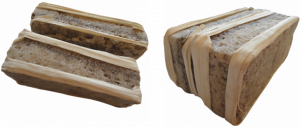
This video explains the use of salt bars as money, through a guided tour of the Geldmuseum, or Money Museum, in Frankfurt, Germany (https://www.youtube.com/watch?v=gXxjdGhv54I).
Currency commonly refers to a form of money, the value of which is guaranteed within a given territory at a given time. For example, the dollar is the US currency, while the euro serves the same purpose for some members of the European Union. Coins are both a form of money and a form of currency. A currency such as the dollar exists in the form of both banknotes and coins (pennies, nickels, dimes, and quarters).
Key Concept: How did money come into being?
Some 2,400 years ago, the Greek philosopher Aristotle (384–322 BCE) believed that “when the inhabitants of one country became more dependent on those of another, and they imported what they needed, and exported what they had too much of, money necessarily came into use. For the various necessaries of life are not easily carried about, and hence men agree to employ in their dealings with each other something which was intrinsically useful and easily applicable to the purpose of life, for example, iron, silver, and the like. Of this the value was at first measured simply by size and weight, but in process of time they put a stamp upon it, to save the trouble of weighing and to mark the value” (Politics I 9.7–8). In another work, the Greek philosopher has a different explanation: “The builder must get from the shoemaker the product of his labor, and must hand over his own in return. If, first, proportionate equality is established, and then reciprocation takes place, the result we mentioned will follow. If not, there is no equality, and the bargain falls through, since there is no reason why what one produces should not be more valuable than what the other produces, and the products must therefore be equated. . . This is where money comes in; it functions as a kind of mean, since it is a measure of everything, including, therefore, excess and deficiency. It can tell us, for example, how many shoes are equal to a house or some food. Then, as builder is to shoemaker, so must the number of shoes be to a house” (Nicomachean Ethics V 5.8–10). One definition is based on the idea that money facilitates trade, the other definition emphasizes money as a standard of value. Money is a substitute for all goods, but also something that is needed for human justice. The second definition implies that money is not just a practical solution to problems of exchange, but also a necessary condition for a certain level of social complexity. Over the last two millennia, philosophers and historians have debated which of the two definitions should be preferred. Both, however, highlight the far-reaching economic and social implications of money.
Wealth was not always stored or measured in money. Even today, a wealthy person is said to be “free from pecuniary anxieties.” Few know, however, that the adjective “pecuniary” employed in that phrase derives from the Latin word for wealth or money (pecunia). Even fewer know that that Latin word derives from the word pecu, which refers to a flock of sheep or, in general, to cattle. How did cattle come to be associated with money? The German economist and historian Bernhard Laum (1884–1974) first noticed that in the Iliad and the Odyssey, the worth of most items is expressed in cattle, even though cattle did not serve as a means of exchange. An ox in the Iliad was not only “wealth,” but also a sacred animal, most appropriate for a ritual sacrifice or for a royal gift, but not for market exchanges. Both bride price (a sum of money that in some traditional societies the groom pays to the bride’s family) and dowry (money that in traditional societies a bride or a bride’s family gives to the groom after the wedding) were paid in cattle. The same is true as a fine for killing, originally a sacrifice meant to appease the victim’s soul. According to Laum, the origins of money as a standard of value developed therefore not from trade, but from the sacrificial practices of Classical Antiquity. The idea of money developed not from exchange between humans, but from the status of the sacrificial animal (the ox) as a substitute for the person performing the sacrifice. In other words, an ox replaced a person, but could in turn be replaced by something else, such as cakes, spits, cauldrons, or tripods (Figure 6.1).[1]

Laum’s theory shifts the emphasis from a pragmatic explanation of money to one that stresses its profound symbolism. People chose certain objects made of certain metals to represent money because they had a distinct idea about what the equivalent should be for all goods, and what the general measure of value should look like. For money to exist, it had to fulfill four major functions. First, it had to serve as a means of exchange, for without money, there is no complex economy. Second, it had to serve as a standard of value, for without it, buildings, shoes, and any other goods could not be compared to each other. Nor could the labor invested by humans in such goods be compared, so the relative, social value of individuals would be difficult to assess. Third, money must serve as a means of storing value. In the absence of any means to refrigerate or salt his catch, a fisherman must sell his fish quickly. The only way for him to “store” the fruits of his labor is therefore to “turn” the fish into money, by means of a fish sale. Incidentally, that is true, albeit on a more symbolic level, for athletes who compete for Olympic gold, as well as for actors and film directors who aspire to win an Oscar—literally a golden statuette. Finally, money has to serve as a means of payment. The fine for killing mentioned above, the bride price, and the dowry are all “payments” that would not be possible without money (Figure 6.2).

All four functions of money have a long history either separately, or in combinations of two or three functions. However, it was the invention of coinage that combined all four functions together for the first time, and radically transformed economy and society. That transformation is ultimately responsible for the economic distinction between the intrinsic and extrinsic (or monetary) value of gold and silver.
Money Before Coinage
Societies in the ancient Near East—Egypt, Babylon, Assyria, Phoenicia, and Israel—used standards of value along with precious metals as a means of payment. However, there were no coins in any of those societies, all of which knew the four functions of money, but did not need them combined into a single object. A court deposition document from the reign of Ramses II (13th century BCE) describes how a merchant sold to an Egyptian lady named Erenofre an enslaved Syrian girl at the price of 4 deben 1 kite (about 373 grams) of silver. In order to pay the price, Erenofre did not actually give the merchant any silver. Instead she made up a collection of clothes and blankets to the value of 2 deben 2 1/3 kite, and then borrowed from her neighbors a miscellany of objects—bronze vessels, a pot of honey, 10 shirts, 10 deben of copper ingots (see Curta, “Copper and Bronze”) to make up for the difference.[2] Similarly, in ancient Mesopotamia, people kept accounts in silver. As in Egypt, silver by weight was a standard means of accounting for the value of different goods. Silver was also used as a means of payment in commercial transactions. When about to make a payment, one need only weigh out the silver. If the weight was uneven, an item was chopped up to make the scale balance, as indicated by pieces of cut silver (hack-silver) found in hoards, such as that buried in el-Amarna (Egypt) at some point during the 14th century BCE (Figure 6.3).
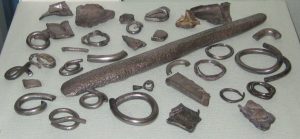
Silver therefore served as money, and both kings and temples established the weight standards and published in inscriptions the values of certain commodities in silver, as well as the amounts to be paid for fines, interest, or wages. However, silver had to be imported into the region, for neither Egypt nor Mesopotamia had any easily accessible sources of that metal. Much of the imported silver was consumed, and even hoarded, by kings, aristocrats, and temples through taxes, tribute, and plunder. Because of its hoarding and consumption, silver had a high extrinsic value and a strong symbolic association with royalty, power, and wealth. No distinction existed between silver as money and silver as jewelry or utensils. Circlets of gold, such as those found in Samaria (Israel) and dated to the early 4th millennium BCE, also point to the lack of that conceptual distinction.[3] Indeed, while meant to facilitate trade, such circlets ended up in hoards (and thus withdrawn from circulation and trade) because of the strong association between precious metals, power, and wealth.
Money in Greece
Gold circlets were not used in Greece in the 8th century BCE. To be sure, Greeks had been in contact with Phoenicians, who used silver as a medium of exchange. But instead of silver, Greeks used cauldrons made of bronze as a medium of exchange: the wealthy were those who possessed many cauldrons and tripods. In addition, iron spits, such as those that archaeologists found in burials, may have served as money. In fact, the smallest silver coins of the Classical age were called oboloi, which means “spits” and six of them made up a drachma (drachme), which means “a handful of spits” (Figure 6.4).

However, unlike silver in Mesopotamia and Egypt, the bronze cauldrons, tripods, and iron spits of ancient Greece never served as general tokens for market exchanges. They were, in fact, utterly inappropriate for that, since they were bulky and heavy. Cauldrons, on the other hand, were still cauldrons, and spits were spits—objects with practical utility. This is in sharp contrast to utensils used in exchanges elsewhere. For example, in China, spades or knives used as money (bu) were completely useless—nothing could be cut with any of them. In that case, it was precisely because they could not be used as utensils that those artifacts were meant to serve as money. By contrast, the utilitarian aspect of those artifacts of ancient Greece that served as means of exchange was never lost. So while money existed in ancient Greece before the invention of the coins, none of the objects chosen for that purpose incorporated all four functions of money.
The Earliest Coins
Long-distance trade and contact with the Near East must have brought to the Greeks the idea of using precious metal as money. Gold and silver were considered valuable possessions in themselves, as shown in the Homeric poems. In the Iliad, Troy is praised for its “wealth of gold,” Thetis is “silver-footed,” while Athena is “golden-haired.” However, silver and gold are conspicuously absent from the archaeological finds from Troy VII, which is believed to correspond chronologically to Homeric Troy.[4] Moreover, gold was not readily available in Greece, as depicted in the legend of Jason and the Argonauts, who had sailed very far from Greece to search for the Golden Fleece.[5] The limited supply of silver and gold may explain why both metals were valuable in the first place. But it may also explain why the earliest coins appear in regions rich in silver and gold. Privileged access to precious metals coincided with the development of political power.
Both the circumstances and the region in which coins were invented are associated with political power. Small bits of metal turned into coins when an impression was hammered or stamped on each one of them (when hammered, such an impression is called “incuse”). It was not the intrinsic value of the metal that mattered, but the extrinsic value of the coin, for which the stamp served as a warranty. The earliest coins were actually made of neither silver nor gold. They were struck in electrum, a naturally occurring alloy of gold and silver that appears in the area of Mount Tmolos (now Bozdağ near Izmir, in western Turkey), which was part of ancient Lydia (Figure 6.5).
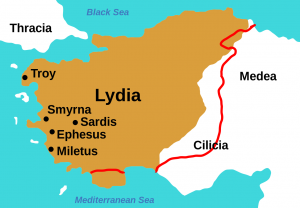
The king of Lydia, Croesus (560–547 BCE) was legendary in antiquity. After conquering most of the Greek cities on the coast, the king wanted to show his generosity to his new subjects. At some point in the 7th century BCE, a large flood had destroyed the Temple of Artemis in Ephesus. Croesus paid generously for its reconstruction. The new temple attracted a great number of merchants, kings, and visitors, and many of them honored the goddess by offering her precious goods and jewels. In the early 20th century, excavations inside the temple led to the discovery of a hoard, which included 93 small pieces of electrum and seven silver nuggets. The electrum pieces have a rough oval shape and seem to be aligned to a system of regular weights: the larger coins are 17.2, 16.1, and 14.1 grams in weight, while the smallest ones are only 1/96 of a larger piece. Those were therefore not just metal nuggets. Moreover, three of them have been marked on one side with an incuse square. Other coins display a figurative design, such as a lion, a stag, or a ram. The head of a lion was the symbol of the Lydian royal house (Figure 6.6).
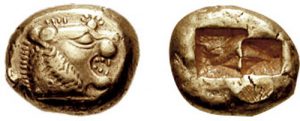
Twenty coins in the hoard have the letters “.WALWE.” inscribed on them, which indicates that they were struck in the name of Alyattes, Croesus’ father.[6] The lion head and the incuse squares were probably royal markers guaranteeing the quality or fineness of the metal. The small size as well as the standardized weight strongly suggest that the purpose of those coins was to make payments in small amounts, for example to the many mercenaries the Lydian king employed. One of those mercenaries probably made an offering in the Temple of Artemis, and the small coins he had received from the king in exchange for military service turned into a votive donation to the goddess. If so, then the transformation of a payment to the mercenary into a “payment” to a goddess suggests that the coins were money, i.e., a means of exchange. In other words, they could have been exchanged for goods on the market. Some scholars have noted that the coins in question are made of an alloy that has less gold than the electrum occurring naturally around Mount Tmolos. The role of the stamps or punches was therefore to make those coins pass for real electrum, even though they had more silver than gold. In other words, the purpose of the punches was to make the metal be recognized and accepted at “face value” rather than by weight, as was the practice in the Near East.
Of course, the coins had some intrinsic, material value as bullion. Nevertheless, as soon as the metal had been minted, it gained a different, symbolic value as a coin, only loosely (and, as it were, deceivingly) connected to its metallic content and purity. Throughout the subsequent history of coinage, both the bullion (contents or purity) and the defined weight would repeatedly be altered, as rulers “inflated” the coins and then from time to time had to introduce mint reforms to restore their acceptability. However, not all stamps on the Ephesus coins were royal, and some may have been private. Some of the earliest coins bear inscriptions in Greek, which read “I am the sign of Phanes” or, on smaller pieces, just “Phanes.” Some of the designs on the electrum coins may also be found on seals and rings of the same period, which strongly suggests that the coins were struck for private, not state, authorities. Moreover, there were no fewer than eight denominations in the Ephesus hoard, an indication that the coins were instruments for payment, either to the state or on the market. The extrinsic value of the coins, guaranteed by their stamps, was therefore of a greater significance in establishing the value of those objects in relation to any other commodities than the value of the metal of which they were made.
From Silver to Gold Coins
Electrum coins had a short life. Croesus began to strike coins in gold and silver, and by the time his kingdom was conquered by Persians in 546 BCE, coins were already in use in all Greek cities on the western coast of what is now Turkey. From there, they were adopted by cities in Greece as well. By the end of the century, there were more than 100 mints operating in Greece. Most of the coins struck in those mints circulated only locally. However, coins from Thrace and Macedonia (both regions rich in silver) appear in hoards discovered outside Greece, a clear indication that the value of those coins was recognized outside the area of their local circulation. The first coins struck in very large quantities were those of Aegina, an island off the coast of Attica, which has no silver resources. Athens, using the silver from the Laurion mines that opened in the 6th century BCE, first struck didrachms before issuing the famous “owl coins,” which became the first international currency in the eastern Mediterranean region (Figure 6.7). Those were also the first widely known, head-and-tail coins (i.e., coins with different images for the obverse and the reverse, respectively), which remained virtually unchanged for 500 years. Within less than a century, the new invention—coined money—spread rapidly throughout the entire Greek-speaking region of the eastern Mediterranean.

The silver coins of Athens also moved to Egypt, the Near East, and the region of the Black Sea—all areas connected to the city by means of trade. As the Greek historian Xenophon put it, “it is sound business to export silver; for where they [the merchants] sell it, they are sure to make a profit on the capital invested.”[7] Xenophon’s point is very important: silver was exported from Athens as bullion, not as coin. The evidence from hoards found in Egypt shows that instead of being treated as coins, the stamped pieces of metal that reached that country by means of trade were chopped and treated as hack-silver with complete disregard for their extrinsic value guaranteed by the stamps.
Throughout the Hellenistic period (323–31 BCE), coins tended to have a higher value within their area of issue than the bullion from which they were made. This may explain why coinage in silver spread so quickly in Classical Antiquity. City-states could increase their revenue by controlling the production of silver and the circulation of overvalued pieces of metal struck as coins. That is why the designs chosen for the Greek coins are in fact symbols of the city-state in which they were struck (e.g., the owl as a symbol of Athens) and are often accompanied by inscriptions giving the city name.
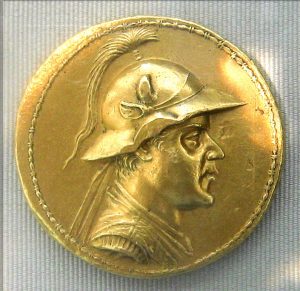
City-states had the legal authority to enforce the overvaluation of silver when paid in the form of acceptable coin. Moreover, many of them were highly attractive markets visited by merchants from all over the Mediterranean region. It is those merchants trading in silver or in some other commodities that prevented the state from incurring the great losses involved in accepting overvalued silver coins. Indeed, coinage was produced especially by those city-states that, like Athens or Aegina, had a strong “trade balance” in their favor. That also explains why the coins of those two city-states became the first international coinages of the ancient world. Access to the rich gold mines in Thrace was the main reason for which the king of Macedonia, Philip II (359–336 BCE) and his son, Alexander the Great (336–323 BCE) struck large numbers of gold coins. In addition, through his conquest of the Persian Empire, Alexander gained control of the enormous wealth accumulated over the years by the Persian kings. Alexander’s successors (the so-called Diadochi) had also access to enormous resources and wealth, and they struck coins in gold, rather than silver. The largest gold coin of the ancient world was struck in the name of Eucratides (ca. 170–145 BCE), who ruled over a large portion of Central Asia centered upon present-day Afghanistan.
During the Hellenistic period, the portraits of the kings came to replace the old symbols of the city-states. Awarded divine status, the kings of Ptolemaic Egypt and Seleucid Syria issued large gold coins with their portraits on the obverse and the symbols of their kingdoms on the reverse. This established the head-and-tail model of coinage that has persisted throughout the medieval and modern age.
For most of its history, the currency of Rome, both during the Republic and during the Empire, consisted of gold, silver, and bronze. The main reason for this monetary system employing three different metals (trimetallism) is the fact that “good” coins with high intrinsic value (gold, but also silver) are typically withdrawn from circulation and hoarded, leaving in circulation only “bad” money in the form of overvalued coins (i.e., coins with very high extrinsic value). This principle, known as Gresham’s law (from Thomas Gresham, the 16th-century financier of King Edward I and of Queens Mary I and Elizabeth I of England), applies especially in times of economic and/or political crisis, encountered many times in Roman history.
Julius Caesar first struck gold coins in very large numbers in order to pay his armies. Under Augustus, a fixed weight for gold coins and a fixed rate of exchange between gold and silver were established for the first time: the aureii were valued at 25 denarii and 41 to the pound (7.87 grams). The gold content was reduced by 4.5 percent under Emperor Nero in 64 CE; however, the rate of exchange between silver and gold did not last very long. When the silver coinage completely collapsed in the 3rd century CE, both silver and bronze were worthless. Gold and goods in kind were now the only means to keep the Roman economy afloat. In other words, in a trimetallic system, gold tends to be placed higher than the other two metals. This is in fact what brought the 3rd-century economic crisis to an end. Emperor Diocletian (284–305) established a new standard weight for the gold coin (now renamed solidus). That coin remained the fundamental axis of the Late Roman and, later Byzantine Empire for the following millennium. The monetary system in both the Late Roman and the Byzantine empires was trimetallic, but its extraordinary stability over a very long period of time (more than a millennium) was possible only by ranking gold higher than silver and bronze. With a fixed rate of exchange of gold into the other two metals, the Roman and Byzantine economies received a monetary platform of recovery and growth.
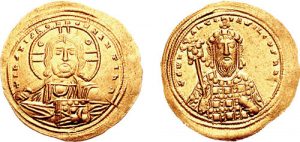
Conclusion
Why were silver and gold chosen for coined money? As explained in the introduction, money fulfills four major functions: means of exchange, standard of value, storage of wealth, and means of payment. However, the choice of a particular material for money depends upon certain basic criteria: durability (that material cannot ruin easily), divisibility (that material must be easy to divide into smaller denominations), portability (that material must be easy to move around), homogeneity (each unit should be the same as all others), and acceptability (people need to recognize that material easily for daily use). In addition, the material chosen needs to be of limited or stable supply, for money is in fact deferred consumption.
From the point of view of a modern engineer, however, any element in the periodic table may served as coined money, as long as it is not a gas, and is neither corrosive and reactive, nor radioactive. To be sure, applying those criteria leave about 30 eligible elements. However, since in order to be coined, a metal must also be rare, the number of elements may be reduced to only eight—the so-called precious metals: rhodium, palladium, osmium, iridium, ruthenium, platinum, gold, and silver. The first five elements were not known before the 19th century, and platinum has a melting point of about 3,000 degrees Fahrenheit, a temperature that was impossible to obtain before the first modern furnaces. That left only gold and silver for the job. Gold is the most malleable of all metals and does not readily react with air. A single gram of gold can be beaten into a sheet of one square meter, or an ounce into 100 square feet. Silver tarnishes when exposed to sulfur compounds in air or water, but has the highest electrical and thermal conductivity of all metals. The conductive properties of gold and silver may not have been either apparent, or indeed necessary to ancient moneyers, but malleability and tarnish resistance were most definitely key properties in selecting gold and silver for coined money. In various languages the very word for “money” derives from words for those two metals: argent in French (derived from Latin argentum, which means silver), arian in Welsh (a word that means both “money” and “silver”), Geld in German (a cognate of Gold), and dengi in Russian (derived from the Turkic word tenge, which refers to a silver coin).
Why is it important to learn about the use of precious metals—gold and silver—for coinage? The application of silver plates to achieve better wound healing is known since the Hellenistic age, and silver nitrate was used medically throughout the Middle Ages.[8] During that same period, the production of the stained glass was based on gold.
However, in both cases, such applications had little, if any, impact on the general perception of silver and gold as precious because of being coinage metals. In other words, until relatively recently, there was little, if any “technological” use of gold and silver that could compete with their primary use for the manufacture of jewelry, liturgical vessels, and coins. It is only recently that new applications have been found for gold, for example, that have dramatically shifted the emphasis away from jewels and coins. The pressure those applications put on the global resources have somewhat contributed to the rising prices of gold. Despite the fact that it is not coined anymore, and that it is used for a number of non-monetary applications, gold is still seen as a strong hedge to inflation and a store of value, since all other assets (bonds, currencies, and cash) can see their values eroded in an inflationary environment. People buy gold for investment purposes. Gold may not have any more the extrinsic value that stamping of overvalued coins gave to the metal in antiquity. However, gold is still a currency and its price fluctuates relative to other forms of exchange. This is also true for silver, which has even more industrial applications accounting for half of the annual demand of that metal. No future engineer interested in the revolutionary applications of the precious metals can therefore ignore the tensions between the intrinsic and extrinsic values of gold and silver. Still, today gold and silver possess the characteristics of a good form of money that have been established by Aristotle. However, they are not coined any more, and that opens a whole range of new possibilities for their use.
Discussion Questions
- What is the difference, both in intrinsic and extrinsic value, between a regular coin and a bitcoin?
- Paper money: the highest extrinsic value possible. How did people come to accept banknotes in monetary exchanges? Why were banknotes acceptable?
- Imagine that world economies will return one day to gold and silver coins. What would the implications of such a decision be for the current (and, possibly, future) applications of gold in advanced technologies in medicine, electronics, or glass production?
Key Terms
aureus
denarius
didrachm
extrinsic
intrinsic
obverse
reverse
stater
tetradrachm
Further Reading
Harris, William V. The Monetary Systems of the Greeks and Romans. Oxford: Oxford University Press, 2010. http://www.worldcat.org/oclc/495598206.
Schaps, David M. The Invention of Coinage and the Monetization of Ancient Greece. Ann Arbor: University of Michigan Press, 2004. http://www.worldcat.org/oclc/849109350.
Wood, Diana. Medieval Money Matters. Oxford: Oxbow, 2004. http://www.worldcat.org/oclc/56641436.
Author Biography
Florin Curta, Ph.D. in History (1998), Western Michigan University, is Professor of Medieval History and Archaeology at the University of Florida. He has published five monographs, over 40 chapters in collections of studies, and more than 100 articles. He is also editor of six collections of studies.
- Bernhard Laum and Heiliges Geld, Eine historische Untersuchung über den sakralen Ursprung des Geldes (Tübingen: Mohr, 1924), http://www.worldcat.org/oclc/868158554. ↵
- Jaroslav Cerny, “Prices and wages in Egypt in the Ramesside period,” Cahiers d’histoire mondiale 4 (1954): 907. ↵
- Avi Gopher and Tsevikah Tsuk, Ancient Gold. Rare Finds from the Nahal Qanah Cave (Jerusalem: Israel Museum, 1991), http://www.worldcat.org/oclc/30622335. ↵
- The World of Troy. Homer, Schliemann, and the Treasures of Priam, Proceedings from a Seminar Sponsored by the Society for the Preservation of the Greek Heritage and Held at the Smithsonian Institution on February 21–22, 1997, eds. Deborah Dickmann Boedeker and Anna Lea (Washington: Society for the Preservation of the Greek Heritage, 1997), http://www.worldcat.org/oclc/38576319. ↵
- Christos Doumas, “What did the Argonauts seek in Colchis?,” Hermathena 40, no. 151 (1991): 31–41, https://www.jstor.org/stable/23040952. ↵
- Robert W. Wallace, “Walwe. and .Kali.,” Journal of Hellenic Studies 108 (1988): 203–207, https://doi.org/10.2307/632647; Gerald M. Browne, “Notes on two Lydian texts” Kadmos 35 (1996): 49–52, https://doi.org/10.1515/kadm.1996.35.1.49. ↵
- Xenophon, Ways and Means, trans. E. C. Marchant (Cambridge, MA: Harvard Univ. Press, 1968), 199, http://www.worldcat.org/oclc/3231818. ↵
- J. Wesley Alexander, “History of the medical use of silver,” Surgical Infections 10, no. 3 (2009): 289–92, https://doi.org/10.1089/sur.2008.9941. ↵

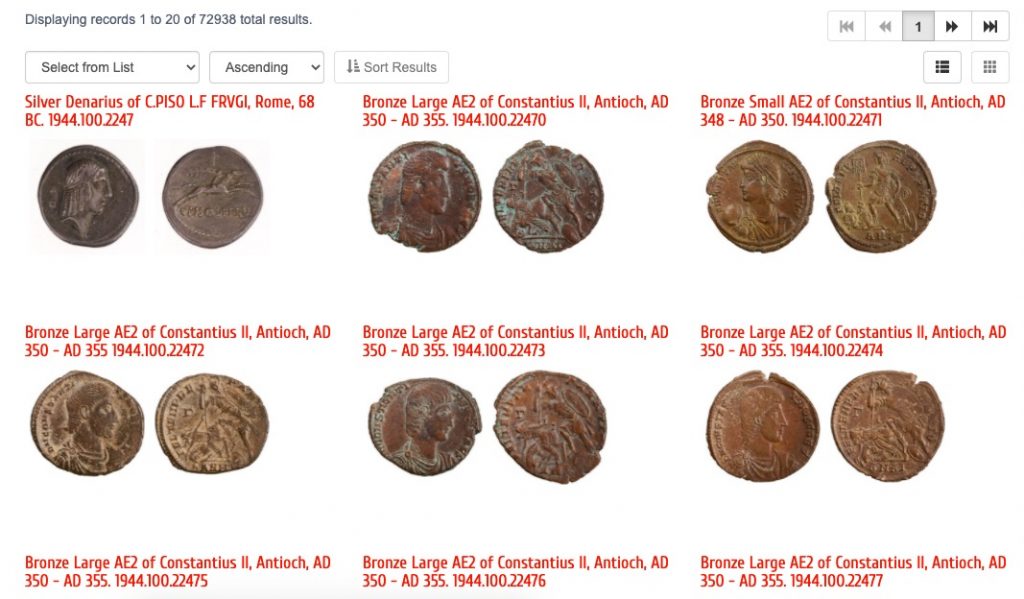

Feedback/Errata